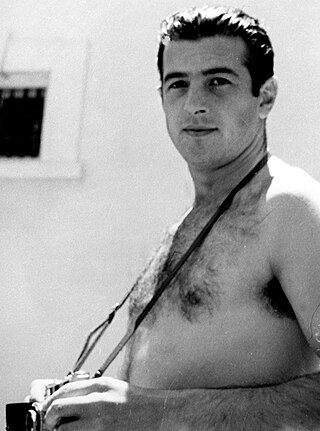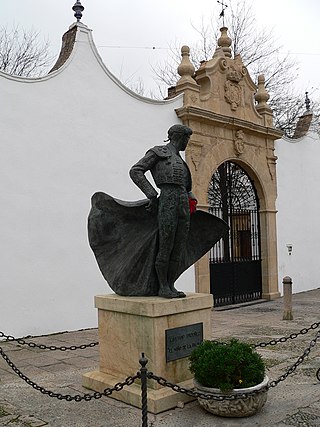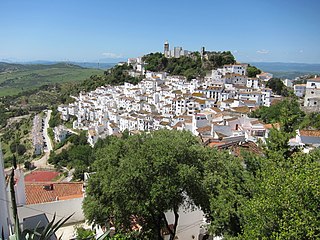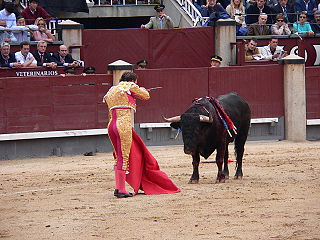Related Research Articles
The name Romero is a nickname type of surname for a Roman or an Italian. The name was originally derived from the Latin word Romaeus and the Greek word Romaios, which mean Roman.
- A person on a religious journey or pilgrimage from Rome

Huelva is a municipality of Spain and the capital of the province of Huelva, in the autonomous community of Andalusia. Located in the soutwest of the Iberian Peninsula, it sits between the estuaries of the Odiel and Tinto rivers on the Atlantic coast of the Gulf of Cádiz. According to the 2010 census, the city had a population of 149,410.

Ronda is a municipality of Spain belonging to the province of Málaga, within the autonomous community of Andalusia.

Pedro Romero Martínez was a legendary bullfighter from the Romero family in Ronda, Spain.

A bullring is an arena where bullfighting is performed. Bullrings are often associated with the Iberian Peninsula, but they can also be found through Iberian America and in a few Spanish and Portuguese ex-colonies in Africa. Bullrings are often historic and culturally significant centres that bear many structural similarities to the Roman amphitheatre.

The Plaza de Toros de Ronda is a Bullring in Ronda, it has a diameter of 66 metres (217 ft), surrounded by a passage formed by two rings of stone. There are two layers of seating, each with five raised rows and 136 pillars that make up 68 arches. The Royal Box has a sloping roof covered in Arabic tiles. The design of the main entrance to the bull ring features two Tuscan columns and the royal shield of Spain surround by baroque edging. The main door is large enough to allow horses and carriages to enter the ring, and above the door is an iron wrought balcony that embodies the bullfighting culture.

Francisco Romero (1700–1763) was a significant Spanish matador. He reputedly introduced the famous red cape (muleta) into bullfighting in around 1726.

Antonio Ordóñez Araujo was a Spanish bullfighter.

Francisco de Asís Rivera Ordóñez is a Spanish torero or 'bullfighter'.

Cayetano Ordóñez y Aguilera is the patriarch of the Ordóñez family of bullfighters.
Romero is family of bullfighters from Ronda, Spain, dating back to the 18th century. The only other family with a comparable history in bullfighting are the Ordóñez, whose founder, Cayetano Ordóñez, "El Niño de la Palmas", was also from Ronda.
Juan Romero was a famous matador. He achieved a reputation as a safe bullfighter and was one of the best paid. He appears as one of the first to condemn improvised bullfights. He organized his own team of assistants and forced bullrings to hire them. According to the Catholic Encyclopedia, he "was the first to organize a cuadrilla de toreros ."

Pasodoble is a fast-paced Spanish military march used by infantry troops. Its speed allowed troops to give 120 steps per minute. This military march gave rise recently to a modern Spanish dance, a musical genre including both voice and instruments, and a genre of instrumental music often played during bullfight. Both the dance and the non martial compositions are also called pasodoble.

Casares is a town and municipality in Spain, located in Málaga province, in the autonomous community of Andalusia.

Antonio Cayetano Rivera Ordóñez is a Spanish torero or 'bullfighter'.
Jose Romero or José Romero may refer to:

Bullfighting is a physical contest that involves a bullfighter attempting to subdue, immobilize, or kill a bull, usually according to a set of rules, guidelines, or cultural expectations.

The traje de luces is the traditional clothing that Spanish bullfighters wear in the bullring. The term originates from the sequins and reflective threads of gold or silver. These trajes are based on the flamboyant costumes of the 18th-century dandies and showmen involved in bullfighting, which later became exclusive to the bullfighting ritual. Later adornments include the montera hat, more elaborate embroidery, and decorative accessories.

Juan José Padilla is a Spanish torero ('bullfighter'). He became a matador de toros, 'killer of (full-grown) bulls', in the town of his birth, Jerez de la Frontera, on June 18, 1994 when he was 21 years old. He was known as the 'Cyclone of Jerez' and featured heavily, both personally and professionally, in Into The Arena: The World Of The Spanish Bullfight, a shortlisted nominee for the William Hill Sports Book of the Year in 2011.
José Manuel Romero Moreno is a Spanish lawyer and university professor.
References
- ↑ "The Romero dynasty".
- ↑ Stokes, Hugh (1914). Francisco Goya: A Study of the Work and Personality of the Eighteenth Century Spanish Painter and Satirist. G.P. Putnam's Sons.
- ↑ Today, Ronda (2016-03-07). "The Romero Dynasty and Ronda's Bandoleros". Ronda Today. Retrieved 2024-02-02.